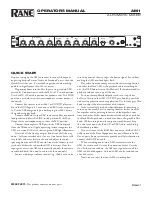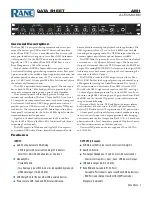
2
7
o al collegamento di un secondo amplificatore, è disponibile
alle prese “OUTPUT BOOTH”(25).
6. Il microfono del DJ va inserito nella presa “DJ MIC”(1). Il
microfono sarà inserito in miscelazione scegliendo “CH1” e
“MIC” con il commutatore (2) .
Un secondo eventuale microfono va collegato alla presa
posteriore “MIC” (29).
7. Alle prese “CH1 PHONO”, “CH2 PHONO” e “CH3
PHONO”(27) andranno collegati giradischi, sintonizzatori,
riproduttori CD, di tipo stereofonico, rispettando il canale
destro(R) e il sinistro(L).
8. Alle prese “CH2 “ e “CH3”(28) potranno essere connessi
compact disc oppure videoregistratori disposti in riproduzione,
ovvero l’uscita di altri analoghi strumenti. L’inserimento sarà
comandato dal commutatore (30) per la scelta d’impedenza
fra segnali tipo PHONO o tipo LINE
9. La presa a morsetto “GND” (23) è il contatto di massa che
andrà collegato alle masse metalliche degli apparecchi.
10. Una lampada per mixer potrà essere connessa alla presa
“LAMP” (12). Ad essa viene fornita una tensione di 12V, 5W.
Accertatevi che la lampada connessa sia compatibile.
10. Alla presa “PHONE” (20) potrà collegarsi una cuffia
stereofonica ( di impedenza non inferiore ad 8 Ohm) o uno
strumento di monitotaggio. Il volume di ascolto sarà regolato
dal comando “LEVEL” (18).
ISTRUZIONI PER IL FUNZIONAMENTO
1. Accensione: Una volta effettuati tutti i collegamenti per il
conveniente inserimento dei Vostri apparecchi audio, basterà
premere il pulsante “POWER”(14) per alimentare il
mixer.Noterete illuminarsi la spia (13). Nel caso in caso in cui
il mixer non dia segno di funzionamento, controllate l’integrità
del fusibile di protezione ed eventualmente sostituitelo con
uno di uguale valore amperometrico. ATTENZIONE: questa
operazione va effettuata a mixer spento e con la spina staccata
dalla rete elettrica.
2. Microfono: Con il commutatore “TALK OVER”(5) su “OFF”
il livello audio microfonico é regolabile con il comando “GAIN”
(3)e “VOLUME” (7); ponendo il commutatore “TALK OVER”(5)
su “TALK” si avrà una forte attenuazione di tutti gli altri segnali
immessi nel mixer, per cui il microfono del DJ diverrà prevalente
su tutti. I comandi “HI”, “MID” e “LOW” (4) offrono la possibilità
di regolare le bande di frequenza del microfono “DJ” donando
la tonalità desiderata entro un campo compreso fra –26 e +12
dB.
3. Selezione ìPHONO/LINE/MICî: Il mixer dispone di tre canali
stereo, comandati ciascuno da un proprio comando lineare
(7). A questi tre canali possono connettersi cinque diversi
strumenti, utilizzando appunto le prese stereofoniche: tre
Phono, due CD/LINE e un Mic. La scelta degli strumenti che
si vogliono inserire in miscelazione è attuabile grazie ai
commutatori “PHONO / LINE / MIC”(2) e al commutatore
posteriore (30). Il segnale scelto potrà essere preregolato
tramite comandi rotanti “GAIN” (3) che aumentano o riducono
il livello dei segnali in ingresso rendendoli compatibili con il
mixer.
FADER” (9) will permit you to introduce an effect of
surrounding fading between the two audio channels con-
nected to inputs “CH1” and “CH2” of the mixer. Generally
the “CROSS FADER” (9) control is left in central position.
7. MASTER control: it is the adjustment that controls the
output of the mixer. All mixed signals combine themselves
in one only output signal which level will be adjusted by
“MASTER”(17) control before connecting to your amplifier
or recorder.
The “MASTER”(17) acts contemporaneously on both the
stereo channels and the output levels for every channel;
can be measured with precision by “LEDS-METERS”(11).
Any level differencies between the stereo channels, must
be adjusted acting on the controls of balancing of the
apparatus connected to the inputs of the mixer.
8. MONITOR (CUE): Connetting a headphone to the
“PHONE”(20) jack you can check the input 1 or 2 it will
depend on what you have choosen through “PFL” switches
(6). The reception level in headphone is adjustable by the
“CUE LEVEL”(18). Instead of the headphone, to the input
“PHONE” (20) could be connected other measure instru-
ments as oscilloscopes, spectrum analyzers, diagram
indicators etc.
Mini linear controller (19) allow you to choose if you want
to ear PFL signal or PGM one. You can also mix them into
your headphone.
9. BPM Circuit: Beat offset leads light up shown how
aligned the beats of CH2 and CH3 are within 11 BPMS of
each other. When it's shown red leds, the beats are not
aligned. When it's shown yellow leds, the beats are almost
aligned. When it's shown green led, the beats are aligned
perfectly.
Note: if the difference between two channel's beat exceed
11 BPM, the beat offset leds will not light up.
























